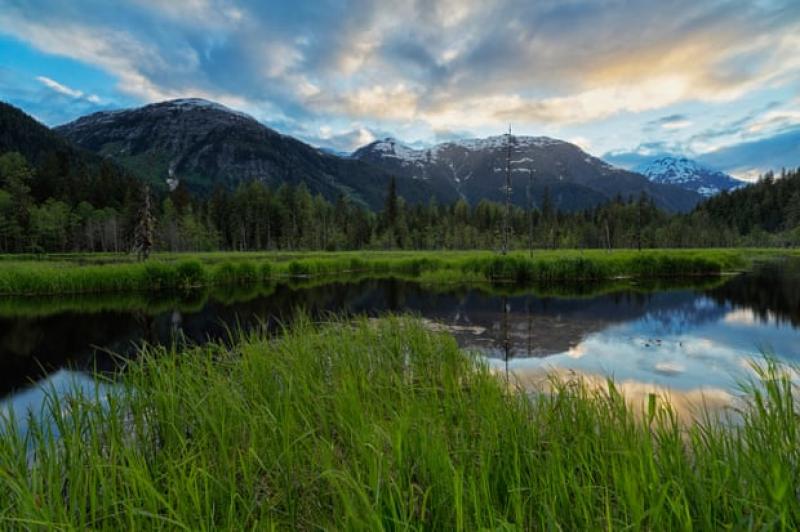Trump to gut protections in Alaska’s Tongass forest, the ‘lungs of the country’
By: Cassidy Randall



The Trump administration has announced it will lift protections in Alaska’s Tongass national forest, permitting logging in the world’s largest intact temperate rainforest.
Experts call the Tongass the “lungs of the country” and one of nation’s last remaining bulwarks against climate change. Located on the southern coast of Alaska , it is made up of centuries-old western cedar, hemlock and Sitka spruce trees, and is home to immense biodiversity, including the largest-known concentration of bald eagles.
“It’s ironic that this administration is trying to tout this president’s environmental record when [Trump is] unwinding environmental safeguards all over the place,” said Ken Rait, project director of the Pew Charitable Trust, who two decades ago helped win the protections that Donald Trump is now undoing. “And lifting protections on the Tongass, the nation’s flagship forest, is about the most egregious of all of them.”
The administration’s decision ignores overwhelming public support for keeping protections in place on the Tongass, including resolutions from six south-east Alaska tribes and six south-east Alaska city councils against lifting protections. Of the public comments solicited on the plan, 96% were in favor of keeping protections in places.
Tribes also petitioned the government to protect customary cultural use areas of the Tongass. “All other avenues to protect our homelands have been exhausted, to little avail,” they wrote in their petition .
The Tongass has been safeguarded since 2001 by a “roadless rule”, which prohibits road construction, road reconstruction and timber harvesting in designated areas of national forests. It barred the construction of roads on some 58.5m acres, and in addition to the environmental benefits, the rule was motivated to protect US taxpayers from the costs of maintaining a web of US Forest Service roads “long enough to go to the moon and most of the way back with no way to maintain them”, said Rait.
Tourism has soared, and the forest support some of the last productive wild salmon runs in the world, and a billion-dollar commercial fishing industry. A 2019 scientific analysis showed that the Tongass absorbs more carbon than any other national forest, on a level with the world’s most dense terrestrial carbon sinks in South America.
After a brief private meeting between the president and the Alaska governor, Mike Dunleavy, aboard Air Force One in June 2019, Trump ordered his administration to lift all protections from the forest.
According to Rait, “between taxpayer expenses and the fact that the majority of logs cut on the Tongass will be exported to China and other Pacific Rim nations, today’s decision isn’t going to have robust economic benefits to anyone in this country.”
A recent report from the Center for Sustainable Economy documented taxpayer losses of nearly $2bn a year from federal logging programs, largely due to the fact that demand for timber has been flagging nationally.
“The Tongass is America’s Amazon,” Adam Kolton, executive director of Alaska Wilderness League, said in a statement. “This presidentially directed move to gut roadless protections for our nation’s largest and most biologically rich national forest is a calamity for our climate, for wildlife and for the outdoor recreation economy of south-east Alaska.”






Dump trump and save our planet!
Dump him-- and let's turn the Senate Democratic as well!
Beyond disgusting.
Some of the last untouched, old wood forests.
And he wants to let it be chopped down, which be not benefit any of us, only a few that are doing the destruction.
A lot of the evil Trump has done is well know.
(Well, unless you get all your news from Fox
However, there have been many instances of his policies allowing (or even causing) serious environmental damage of which many people are unaware.
They somehow turn a blind eye and actually believe him when he says he is helping the environment...
Sickening.
Getting as much graft as possible...
Trump administration strips protection from US’s largest forest
Timber harvest and road construction is now allowed for more than three million hectares of Tongass National Forest
Bob Strong/Reuters
The Trump administration has lifted environmental protection in the largest forest in the United States, opening up more than three million hectares in Tongass National Forest to logging despite opposition from environmental groups and Indigenous leaders.
In an official notice of the decision on Thursday, the US Department of Agriculture said Tongass would be exempt from a 2001 federal law known as the “Roadless Rule” that prohibits timber harvest and road construction in specific areas.
The Tongass – sometimes referred to as “America’s Amazon” – spans nearly seven million hectares (17 million acres) across southeast Alaska, including the capital, Juneau, and is home to diverse wildlife and trees. It is considered the largest contiguous temperate rainforest in the world.
Alaska’s Republican governor, Mike Dunleavy, welcomed the Trump administration’s decision, which opens up 55 percent of the forest (3.9 million hectares/9.6 million acres) to timber harvest activities and road-building.
“This will help build community resilience and support economic recovery in a region that’s been hit hard by the devastating effects of the COVID-19 pandemic on tourism and other industries relying on responsible use of our natural resources and beauty,” Dunleavy said in a statement.
The US Department of Agriculture said lifting the roadless rule could be done “without major adverse impacts to the recreation, tourism, and fishing industries, while providing benefits to the timber and mining industries, increasing opportunities for community infrastructure, and eliminating unnecessary regulations”.
Environmental groups and Indigenous leaders say the move endangers the diverse ecosystem, however, and they have slammed US President Donald Trump for what they view as another rollback of environmental protections in the country.
Trump has faced rebuke for years over his administration’s environmental policies and for rejecting the need to act to mitigate the climate crisis.
In August, the Trump administration opened up part of another key ecological site in Alaska, the Arctic National Wildlife Refuge, to oil and gas exploration.
‘Reckless and irresponsible’
Ken Rait, project director for public lands and rivers conservation at Pew Charitable Trusts, said in a statement that there is “no scientific or economic” basis to allow logging in Tongass.
“This decision is a disservice to Alaskans and other Americans who value these ancient trees and the lives and livelihoods they support. The Tongass is a global gem. Once these pristine forests are gone, they’re gone forever,” Rait said.
The Alaska Wilderness League also said the decision could, among other negative effects, threaten the fishing industry, which relies on the rivers and streams of the forest for its salmon harvesting.
“The Tongass is America’s Amazon. Its lush islands, towering trees, glacial fjords and estuaries support some of the highest concentrations of bald eagles, brown bears and wild salmon anywhere in the world,” the group’s executive director, Adam Kolton, said in a statement.
“Taking an axe to old-growth protections for the Tongass is among the most reckless and irresponsible of the Trump administration’s environmental rollbacks.”
Indigenous groups have also raised alarm over the Trump administration’s plan to open the national forest up to logging.
In an opinion piece published by Alaska media outlets in October 2019, Richard Chalyee Eesh Peterson, president of the Central Council of Tlingit and Haida Indian Tribes of Alaska, said Indigenous governments had not been listened to in the decision-making process.
Peterson said tribes in southeast Alaska are united in their relationship to the place now known as Tongass. “Our health and well-being, identity and worldview are intricately woven into the fabric that is our homeland,” he wrote.
“Southeast Alaska tribes believe the requisite environmental process has been arbitrarily and capriciously rushed to decision despite the magnitude of potential adverse impacts that lifting these protections could be expected to impose upon our homelands.”
The village idiot strikes again.
Next on the list is the Boundry Waters in Northern MN one of the most pristine areas in the lower 48.
As icing on the cake, I read that a lot of the timber they get from destroying an old world forest, will be shipped to China...
Just in case you haven't had enough bad news...
‘Premature and reckless’: US ending grey wolf protection
Conservation groups slam the decision by the administration of President Donald Trump to remove the grey wolf from the US endangered species list.
the first time in over 200 years that the endangered animals have lived in the New Jersey area
JC/CM/CLH
The United States has announced plans to remove the grey wolf from its list of endangered species , saying recovery efforts have been successful and the animal no longer requires federal protection.
In a statement on Thursday, the US Fish and Wildlife Service said state and tribal wildlife agencies would soon take responsibility for ongoing sustainability efforts and protection of the species.
The agency said there are more than 6,000 grey wolves across the lower 48 US states – all the US states except Hawaii and Alaska.
The grey wolf is now “neither a threatened nor endangered species” under the Endangered Species Act, US Secretary of the Interior David Bernhardt said in the statement.
“Today’s action reflects the Trump administration’s continued commitment to species conservation based on the parameters of the law and the best scientific and commercial data available,” Bernhardt said.
The Natural Resources Defense Council (NRDC) immediately rejected the move by the administration of US President Donald Trump, however, saying the species requires continued protection because the US does not have a national wolf recovery plan in place.
Two grey wolf pups peek out from a log in the
Rogue River-Siskiyou National Forest in Medford, Oregon
Oregon Fish & Wildlife/Handout via Reuters
Fallon said in a statement that grey wolves are still missing from much of their remaining habitat in the western and northeastern US and she accused decision-makers of “prioritising politics over science”.
Kristen Boyles, an attorney with the environmental legal group Earthjustice, echoed that.
“This delisting decision is what happens when bad science drives bad policy,” she said in a statement signed by a handful of environmental groups that vowed to fight the Trump administration’s decision in court.
You cannot have a national wolf recovery without putting forward a national wolf recovery plan. This still has not happened.
SYLVIA FALLON, NATURAL RESOURCES DEFENSE COUNCIL
“Stripping protections for grey wolves is premature and reckless. Grey wolves occupy only a fraction of their former range and need continued federal protection to fully recover,” said Jamie Rappaport Clark, president and CEO at Defenders of Wildlife, another conservation group.
“We will be taking the US Fish and Wildlife Service to court to defend this iconic species.”
The grey wolf historically lived across two-thirds of the country, the National Wildlife Federation says on its website , but today its population is found in Alaska and parts of Michigan, Wisconsin, Montana, Idaho, Oregon and Wyoming.
The animal was added to the endangered species list in 1978.
The US Fish and Wildlife Service said its decision will be published in the federal register on November 3 and come into effect 60 days later on January 4, 2021.
The agency said Thursday that the Mexican wolf, a subspecies of the grey wolf found in New Mexico and Arizona, remains on the endangered species list.
Sadly, I heard this.
I grew up in an area of the US that had the largest concentration of wolves in the lower 48.
If the wolves are on Indian reservations in MN they will still be protected as the Ojibwe will not allow them to be hunted. PERIOD
How much damage, how fast...